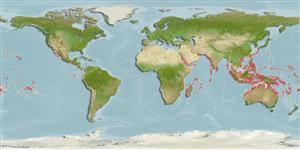>
Gobiiformes (Gobies) >
Gobiidae (Gobies) > Gobiinae
Etymology: Asterropteryx: Greek, a = with + Greek, sterros, -a, -on = consistent + Greek, pteryx = fin (Ref. 45335).
More on author: Rüppell.
Environment: milieu / climate zone / Tiefenbereich / distribution range
Ökologie
seewasser riff-verbunden; tiefenbereich 1 - 20 m (Ref. 9710). Tropical; 30°N - 32°S
Indo-Pacific: Persian Gulf (Ref.80050) and Red Sea to the Hawaiian, Line, and Tuamoto Islands, north to southern Japan, south to Lord Howe and Rapa.
Size / Gewicht / Alter
Geschlechtsreife: Lm ? range ? - ? cm
Max length : 6.5 cm TL Männchen/unbestimmt; (Ref. 11344)
Rückenflossenstacheln (insgesamt) : 7; Rückenflossenweichstrahlen (insgesamt) : 9 - 11; Afterflossenstacheln: 1; Afterflossenweichstrahlen: 8 - 9. Body tan to black in color with light spots; midside with small elongate dark spots; short vertical bars or saddles above (Ref. 2798); characterized further by prolonged third dorsal spine , forms long filament in adult; longitudinal scale series 23-25; ctenoid scales; head scaled except snout and interorbital space; 3-9 close-set spines on edge of preopercle just above the corner; rounded caudal fin; depth of body 3.0-3.6 in SL (Ref. 90102).
Body shape (shape guide): elongated.
Found on algal-coated reef rock and rubble of inner flats and turbid lagoons (Ref. 1602). Takes refuge in burrows or holes in the reef (Ref. 11441). Benthic (Ref. 58302). Feeds on small benthic invertebrates (Ref. 89972). Solitary or in small group (Ref 90102).
Life cycle and mating behavior
Geschlechtsreife | Fortpflanzung | Ablaichen | Eier | Fecundity | Larven
Benthic spawner.
Myers, R.F., 1991. Micronesian reef fishes. Second Ed. Coral Graphics, Barrigada, Guam. 298 p. (Ref. 1602)
IUCN Rote Liste Status (Ref. 130435: Version 2025-1)
Bedrohung für Menschen
Harmless
Nutzung durch Menschen
Fischereien: kommerziell; Aquarium: Kommerziell
Tools
Zusatzinformationen
Download XML
Internet Quellen
Estimates based on models
Preferred temperature (Ref.
123201): 24.7 - 29.3, mean 28.2 °C (based on 3295 cells).
Phylogenetic diversity index (Ref.
82804): PD
50 = 0.5020 [Uniqueness, from 0.5 = low to 2.0 = high].
Bayesian length-weight: a=0.01000 (0.00631 - 0.01585), b=3.16 (3.03 - 3.29), in cm total length, based on LWR estimates for this species & (Sub)family-body (Ref.
93245).
Trophic level (Ref.
69278): 2.4 ±0.00 se; based on food items.
Widerstandsfähigkeit (Ref.
120179): hoch, Verdopplung der Population dauert weniger als 15 Monate. (Preliminary K or Fecundity.).
Fishing Vulnerability (Ref.
59153): Low vulnerability (10 of 100).
🛈
Nutrients (Ref.
124155): Calcium = 232 [109, 547] mg/100g; Iron = 1.19 [0.55, 2.44] mg/100g; Protein = 17.6 [15.5, 19.4] %; Omega3 = 0.0845 [, ] g/100g; Selenium = 31.9 [12.9, 79.5] μg/100g; VitaminA = 79.7 [17.2, 348.2] μg/100g; Zinc = 3.25 [1.99, 5.03] mg/100g (wet weight);
